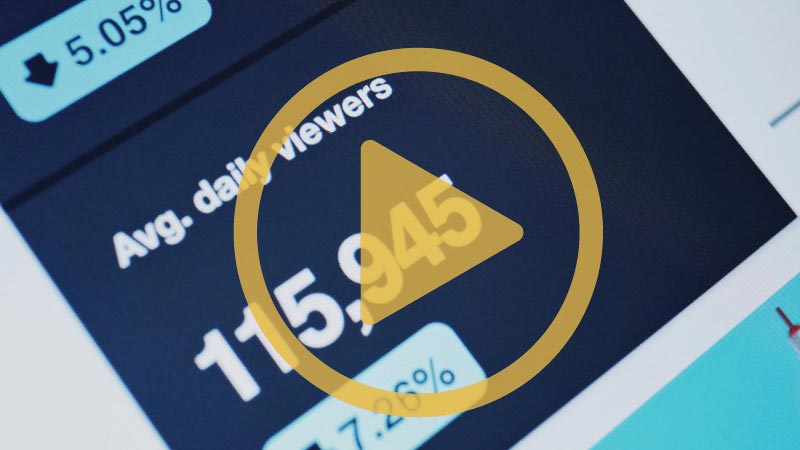After the initial strategy, ideation, creative storyboarding, shooting and editing, you’ve finally done it. You’ve produced an amazing, sure-to-go-viral piece of video content. Congrats, you savvy, forward-thinking marketer, you. But now what? How will the masses see your masterpiece?
Distribution is the name of the game.
1. INCREASE VISIBILITY
Put your video on a variety of platforms to ensure users can find them. Start by uploading videos to Vimeo or YouTube. What’s the difference? YouTube is slightly more user friendly, while Vimeo allows for more enhanced white-labeling features, like clean branding.
Consider YouTube if you’re looking to scale your content quickly, as it’s inherently meant for social sharing. Choose Vimeo if you’re targeting a small, engaged audience that is more concerned about quality. Once your videos are uploaded to a hosting platform, embed them onto your website.
2. OPTIMIZE VIDEO BASED ON PLATFORM
Video viewers are loyal to their platform of choice. For example, if a user in your target audience regularly consumes content on Facebook versus YouTube, it’s necessary to distribute and optimize your video content on Facebook. This same example applies for users across platforms, so it’s important to be where your target audience hangs out. A cross-distributional strategy ensures that every video you publish will find an audience.
A full list of optimization tactics for each distribution platform could be a blog post of its own, but we’ve compiled a quick list to get you started.
- YouTube — As the second-largest search engine next to (and owned by) Google, housing videos on YouTube has inherent SEO benefits. Make sure to optimize titles and descriptions for search using keywords. Utilize end screens, cards and playlists to increase viewership, engagement and search.
- Facebook — When publishing to Facebook, upload video directly. Facebook prioritizes native video and allows for larger thumbnail, autoplay and a consistent experience for the user. Make sure your video ads appeal to viewers even when muted by using on-screen text to help tell your story.
A Facebook study of more than 300 video ad campaigns found that 73% of them had a significant lift in ad recall, and the average lift between test and control groups was 86%.
- Twitter — You can publish to Twitter with a link from your site or direct upload. Consider making a 140-seconds-or-shorter clip of your video and Twitter will autoplay it in user feeds.
- Instagram — Instagram videos range from 3 to 60 seconds long and loop automatically. There are a couple applications to enhance your video for Instagram.
- Boomerang — Boomerang creates GIF-like short videos that loop forwards and backwards. Common on Instagram, these videos tend to see good engagement.
- Hyperlapse — Hyperlapse allows you to capture high-quality time-lapse videos even while in motion, giving you control over the speed at which your time lapse plays. Hyperlapse is often used to capture events that would normally be too long to share (think: open house, launch party, etc.).
- LinkedIn — Currently, the only way to share a video on LinkedIn is by posting a link to the video; however, LinkedIn recently announced that it will start rolling out native video to all profiles. A recent report from the Social Media Examiner found that LinkedIn seems to significantly prioritize native content. Keep checking those publishing bars for video.
- Snapchat — Snapchat videos must be less than 10 seconds long (other than Snap Ads) and need to be recorded through the Snapchat app. Shoot video vertically, as users are overwhelmingly mobile. Make sure to save your video content to Snapchat memories so you can repurpose it for other platforms.
- Email – Using the word “video” in an email subject line boosts open rates by 19% and clickthrough rates by 65%. Not only will video help to increase open and click rates, but it also gives users a streamlined platform to share your content — just make sure to include clear Calls-To-Action.
3. REPURPOSE EVERGREEN CONTENT
You don’t wear a shirt once and throw it away, do you? The same goes with video content. When you don’t repurpose video content you’re essentially throwing it away, because the chances of someone finding it organically are relatively low.
All content without a shelf life (evergreen content) should be posted more than once across relevant social networks. This strategy allows your video to reach users who may have missed your content the first time around, live in a different time zone or are new to your page.
Quick tips for repurposing video content:
- Repost content during evenings and weekends. On the weekend, reposts see twice as much volume as original content.
- Twitter can be repurposed the same day, while all other reposts should be spaced out by at least 30+ days.
- Include different highlights from the article in social copy. This may attract users it missed the first time.
- Test title copy. If one significantly outperforms the other, adjust the video title to be better optimized for search where it’s hosted.
4. VIDEO POSTING FREQUENCY
Posting frequency varies by platform and should follow industry best practices. Video content should be treated as another category in your content mix (i.e., blog posts, static graphics, infographics, etc.). Test different content types across platforms to determine your ideal mix.
Pro Tip: When publishing on YouTube, post on a designated day of the week, so audiences know when to expect your next video.
5. REACH NEW AUDIENCES
There are several ways to expand your video-viewing audience. One of the most effective ways to reach more people is to encourage your internal audiences to act as advocates for your brand and share company content. Messages coming from a friend are far more credible and usually receive higher engagement than messages shared by a brand. Social sharing also builds external links that help increase search engine rankings.
Brand messages reached 561% further when shared by employees versus the same messages shared via official brand social channels.
Another way to expand your audience is to leverage additional profiles. Do you have another line of business where a particular video would make sense? Is there a page that you engage with regularly? Ask if they’ll post your content.
Sharing video on other profiles can increase video reach and exposure by tapping into existing audiences. External social linking can also give you a nice SEO boost.



